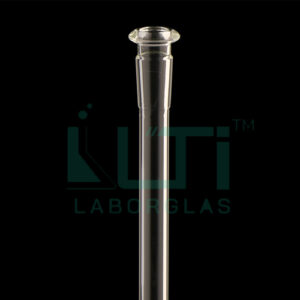| PART No. | SIZE,MM | PACK SIZE |
| 7506-38 | 38 X 250 | 1 |
| 7506-50 | 50 X 300 | 1 |
| 7506-60 | 60 X 300 | 1 |
Here are some typical uses of an absorption tower with calcium chloride:
- Drying Gases:
- The primary purpose of this apparatus is to dry gases by passing them through the tower. Calcium chloride is a highly hygroscopic substance, meaning it readily absorbs moisture. Gases passed through the tubular section at the bottom of the tower come into contact with the calcium chloride, effectively removing water vapor.
- Moisture Removal in Laboratory Settings:
- In laboratory setups where it is essential to ensure that gases are dry, the absorption tower with calcium chloride is employed. It helps prevent interference from moisture in various experiments, especially those involving sensitive reactions or instruments.
- Protection of Reagents:
- The absorption tower is used to protect reagents and reactions that are sensitive to moisture. By drying the gases before they come into contact with other chemicals, unwanted side reactions due to moisture are minimized.
- Gas Purification:
- Gas streams used in analytical techniques, such as gas chromatography or spectroscopy, must be free from moisture to ensure accurate results. The absorption tower with calcium chloride aids in purifying gases for these applications.
- Desiccation in Chemical Synthesis:
- In chemical synthesis, particularly in reactions that require anhydrous conditions, the absorption tower helps maintain a dry environment. This is crucial for reactions involving moisture-sensitive reagents.
- Solvent Drying:
- The apparatus can be used to dry solvents by passing them through the tubular section containing calcium chloride. This is important in processes where the presence of water can affect the outcome of the reaction.
- Protection of Sensitive Instruments:
- Instruments such as mass spectrometers or infrared spectrometers may be sensitive to moisture. The absorption tower ensures that the gases supplied to these instruments are dry, preventing interference and maintaining instrument integrity.
- Air and Gas Sampling:
- When collecting air or gas samples for analysis, the absorption tower helps remove moisture from the collected sample, ensuring that subsequent analyses are not compromised by the presence of water vapor.
- Educational Demonstrations:
- In educational settings, this type of absorption tower is often used to demonstrate principles of gas drying and the hygroscopic properties of calcium chloride.





